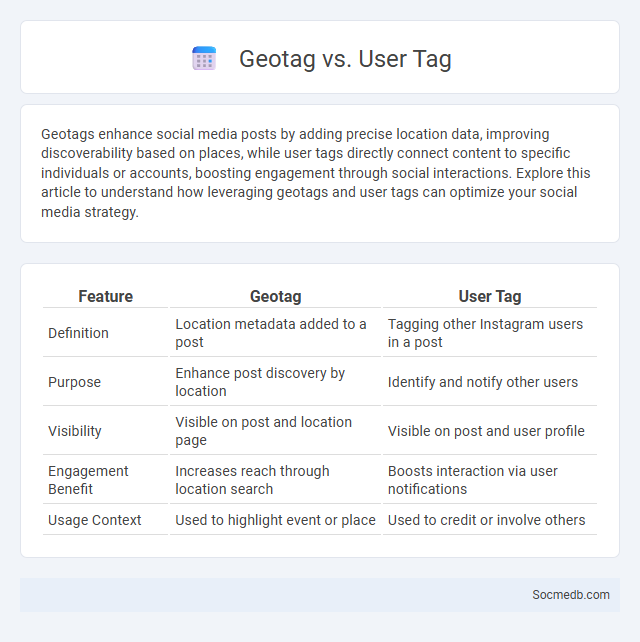
Photo illustration: Geotag vs User Tag
Geotags enhance social media posts by adding precise location data, improving discoverability based on places, while user tags directly connect content to specific individuals or accounts, boosting engagement through social interactions. Explore this article to understand how leveraging geotags and user tags can optimize your social media strategy.
Table of Comparison
| Feature | Geotag | User Tag |
|---|---|---|
| Definition | Location metadata added to a post | Tagging other Instagram users in a post |
| Purpose | Enhance post discovery by location | Identify and notify other users |
| Visibility | Visible on post and location page | Visible on post and user profile |
| Engagement Benefit | Increases reach through location search | Boosts interaction via user notifications |
| Usage Context | Used to highlight event or place | Used to credit or involve others |
Understanding Geotag: Definition and Uses
A geotag is metadata embedded in your social media posts that includes geographic coordinates, enabling platforms to pinpoint the exact location of your content. Understanding geotags enhances your ability to organize and share location-specific experiences, improving engagement and reach. Leveraging geotags strategically can boost local visibility and connect your audience with relevant places tied to your posts.
What is a User Tag?
A user tag in social media refers to a clickable link that identifies and connects to a specific user's profile within a post or comment. It enables your content to reach the tagged individual directly and increases engagement by notifying them about the mention. User tags enhance social interaction, making it easier to attribute content and foster online communication among users.
Key Differences Between Geotag and User Tag
Geotags associate your social media posts with specific geographic locations, allowing content to be discovered based on place, while user tags link profiles or accounts of individuals featured or mentioned in the post. Geotags enhance content visibility by enabling location-based searches and trends, whereas user tags boost engagement by notifying tagged users and connecting their networks. Understanding the distinction helps you optimize social media strategies for targeted reach and personalized interactions.
How Geotags Enhance Content Discovery
Geotags significantly boost content discovery by linking posts to specific locations, making them easily searchable for users interested in those areas. Platforms like Instagram and Twitter leverage geotag data to curate localized content feeds and trending topics, increasing visibility and engagement. This spatial metadata enables brands and creators to target audiences based on geographic preferences, enhancing marketing precision and user interaction.
User Tags and Social Media Engagement
User tags enhance social media engagement by directly involving your audience in conversations and increasing content visibility across networks like Instagram, Facebook, and Twitter. Strategic tagging facilitates personalized interactions, encourages user-generated content, and boosts algorithmic preference, driving higher reach and follower growth. Maximizing the use of relevant user tags encourages active participation and fosters community building around your brand.
Geotag Use Cases in Marketing
Geotag use cases in marketing enable precise audience targeting by associating social media posts with specific locations, boosting local brand visibility and engagement. Your campaigns can leverage geotag data to analyze consumer behavior patterns, optimize store visits, and run location-based promotions that drive foot traffic and sales conversions. Integrating geotags with social media analytics tools enhances market segmentation and delivers personalized content tailored to regional preferences.
User Tag Best Practices for Brands
User tagging on social media enhances brand visibility and engagement by fostering authentic connections with audiences. Brands should tag relevant users or partners thoughtfully to avoid spamming and ensure contextually appropriate interactions, which improves reach and credibility. Employing a strategic tagging approach aligns with platform algorithms, increasing content discoverability and driving targeted traffic to brand profiles.
Advantages and Limitations of Geotagging
Geotagging on social media enhances user engagement by allowing precise location-based content sharing, which improves discovery and local networking opportunities. It also supports businesses in targeted marketing campaigns by providing valuable location data to tailor advertisements effectively. However, geotagging raises privacy concerns, exposing users to potential location tracking risks and unauthorized data usage.
Privacy Implications of Geotags vs User Tags
Geotags in social media posts expose your precise location data, potentially increasing risks of privacy breaches and unwanted tracking. User tags link your profile directly to posts or photos, which can amplify visibility and expose personal connections to a wider audience. Balancing geotag usage with cautious user tagging helps minimize inadvertent sharing of sensitive information and protects your privacy online.
Choosing Between Geotag and User Tag for Your Strategy
Choosing between geotag and user tag for your social media strategy depends on your marketing goals and target audience engagement. Geotags enhance local discovery by associating posts with specific locations, driving foot traffic and increasing brand visibility in targeted areas. User tags foster community and personal connections by directly involving influencers or customers, boosting interaction, credibility, and shareability.
 socmedb.com
socmedb.com